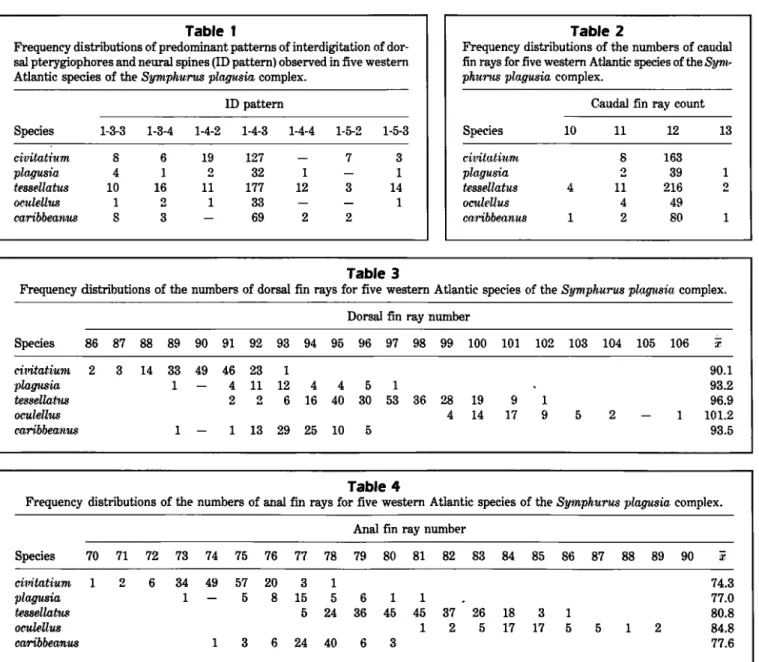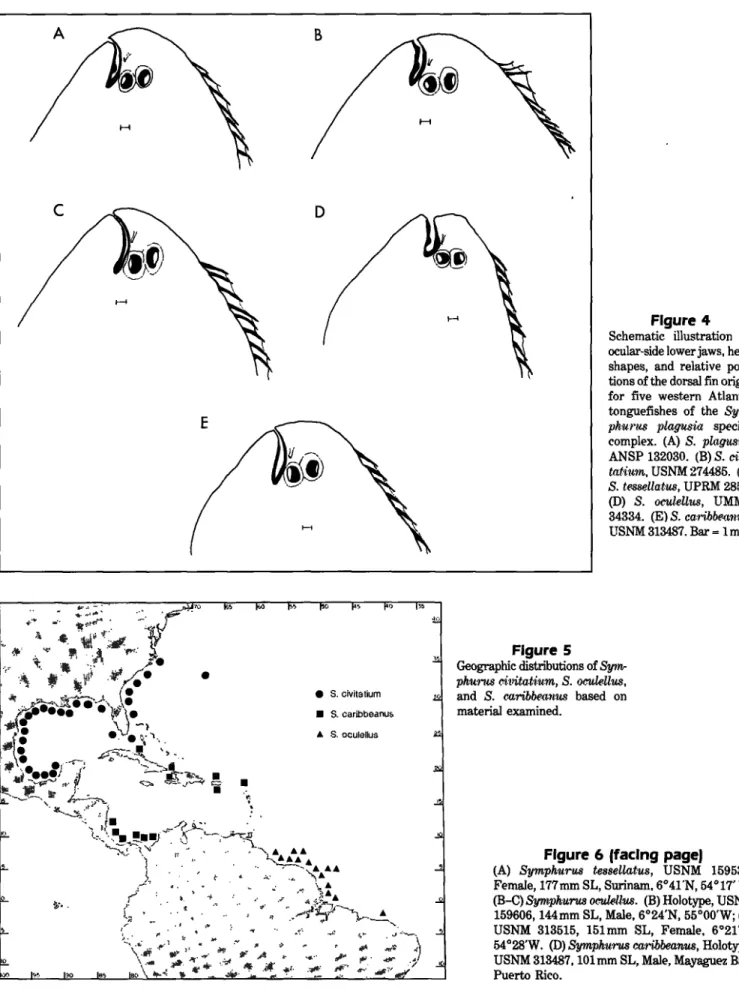Frequency distributions of dorsal fin ray numbers for five western Atlantic species of the Symphurus plagusia complex. Frequency distributions of anal fin ray numbers for five western Atlantic species of Sl/Inphurus plagusia. The specimen has 99 dorsal fin rays, 83 anal fin rays, 12 caudal fin rays, 53 total vertebrae, several small ctenoid scales on the blind sides of the dorsal and anal fin rays, the dorsal fin origin vertically through the leading edge of the pupil of the upper eye, and a relatively large eye (10.6% HL).
Viewed from the blind side, the most posterior location of the origin of the dorsal fin in S. In larger S.plagiusa (>60 mm SL) there are 4-8 ctenoid scales on the blind sides of the dorsal and anal pectoral rays (scales usually absent altogether, or occasionally 1-2 scales along bases of fin rays in S. plagusia). Symph-u.- 'rus plagusialacks scales on the blind sides of the dorsal and anal fin rays and peritoneum with dots that are present in S .
Other differences between these species include the absence of scales on the blind sides of the dorsal and anal fin rays of S. In addition, the specimen has small ctenoid scales on the blind sides of the dorsal and anal fin rays and a relatively large eye (10.6% HL), features characteristic of S . 3-2 in S. marginatus), hypural number (4 vs. 5), the presence of scales on the blind sides of the dorsal and anal fin rays in S.
Further differences include the presence of small ctenoid scales on the blind sides of the dorsal and anal thoracic rays in S. -2-1-2 in S. . vanmelleae in S. ligulatus, and 1-3-2-2-2 in S. marginatus), peritoneal pigmentation (unpigmented vs. black in others) and dorsal and anal fin pigmentation (alternating series of spots and unpigmented areas in S. oculellus versus uniformly pigmented feathers in other species). 110~. In contrast, of the eleven other Atlantic species that possess 12 caudal fin rays (all have a 1-3-2 ID pattern), seven species typically inhabit many waters on the continental shelf and upper continental slope, ranging from 35 to 700 m, with centers of abundance usually between 100 and 350 m (Munroe 1987).

Acknowledgments
Most specimens were captured with beach seines and small otter trawls at depths less than 10 meters in tidal flats, mangrove habitats and estuarine locations. Symphurus oculellus lives in deeper waters than the others (Table 11), with a total depth range of 7-110 meters, but is most often captured in waters deeper than 20 meters (78% collected deeper than 20 meters). Symphurus oculellus, including juveniles as small as 76 mm SL, have been collected from neritic waters deeper than 7 meters and none have been collected from estuarine habitats, unlike S.
Symphurus civitatium, the northernmost species, is the only Atlantic species with an allopatric distribution to other members of this species group. For example, the deepest catches of this species were made at 73 and 62 m, where one fish was caught each time, and of the four fish collected in waters shallower than 10 m, only one was an adult and the other three were small. youth "35 mm SL). The occurrence of early life stages in coastal waters suggests a life history pattern similar to that of S.
However, distribution data for this species, especially those of early juveniles, are too incomplete to estimate how regularly this species uses coastal waters as a nursery. Further research is needed to determine whether recent captures of early juveniles in estuarine environments represent isolated occurrences of this species or represent the normal life history pattern. Symphu-rus civitatium is only slightly larger, reaching a maximum length of 152 mm SL and maturing at sizes slightly larger than 90 mm SL. Symphurus oculellus and S.
Comparisons of ecological and life history parameters, such as those above, complement and confirm systematic determinations based on morphological evidence. However, in the absence of a cladistic hypothesis, the value of these ecological comparisons, especially regarding historical conditions, either of the species complex within the genus or of the individual species comprising S. Further investigation, based on shared derived characters using outgroup comparisons, or ontogeny, is needed before intrageneric relationships of the species complex and interrelationships among its members can be determined to better understand trends in the evolution of life history traits of these soles.
This study would not have been possible without the help provided by many people, whose generosity is greatly appreciated. Additional financial support was provided by Sigma Xi, the Raney Fund, and William and Mary Small Research Grants. Assistance during many phases of this study was provided by Susan Jewett and Jeff Williams, who assisted in locating material, cataloged specimens, or provided advice regarding x-ray films and use of the x-ray facility at the USNM;K.Bruwelheide , A.
Citations
1842 New York Zoology; or Fauna of New York; containing detailed descriptions of all the animals hitherto observed in the State of New York. 1896 Oceanic Ichthyology, a treatise on the deep-sea and pelagic fishes of the world, based chiefly on collections made by the steamers Blak.e, Albatross, and Fish Hawk in the north-west Atlantic, with an atlas containing 417 figures. 1981 Studies on the composition and organization of the demersal ichthyofauna of the continental shelf area in the Northeastern Gulf of Mexico.
1976 On the species of the genus SymphuruJJ of the Brazilian coast, with descriptions of two new species (Osteichthys. Pleuronectiformes, Cynoglossidae). 1965 Fish taken in monthly trawl samples off the coast of Pinellas County, Florida, with new additions to the fish fauna of the Tampa Bay area.
